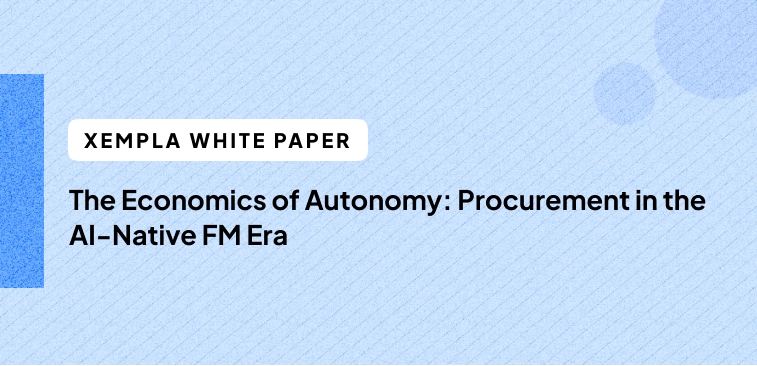
Facilities Management is entering a new performance economy. This white paper explores how AI-native autonomy is transforming procurement — shifting FM contracts from buying tools and licences to commissioning verified outcomes. Discover how AI-driven maintenance, assurance, and operations are redefining cost, margin, and value creation. Learn how adaptive, gain-share models can replace static SaaS fees — rewarding efficiency, performance, and measurable impact across the entire FM value chain.
Lorem ipsum dolor sit amet, consectetur adipiscing elit, sed do eiusmod tempor incididunt ut labore et dolore magna aliqua. Ut enim ad minim veniam, quis nostrud exercitation ullamco laboris nisi ut aliquip ex ea commodo consequat. Duis aute irure dolor in reprehenderit in voluptate velit esse cillum dolore eu fugiat nulla pariatur.
Block quote
Ordered list
Unordered list
Bold text
Emphasis
Superscript
Subscript
Facilities Management (FM) is at a turning point.
For decades, FM contracts have been cost-driven, labour-intensive, and reactive. The focus of “digital transformation” in FM has largely been on analytics — systems that detect faults, monitor performance, and visualise data. Yet these tools rarely change the underlying economics of service delivery.
The next evolution is here: AI-Native FM, where technology does not just provide insight but actively manages and optimises operations.
AI-Native FM enables autonomy — systems that diagnose, plan, prioritise, and orchestrate maintenance, compliance, procurement, and finance functions. The shift from analytics to autonomy represents the most significant re-engineering of FM operations since Computerised Maintenance Management Systems (CMMS) were introduced.
This white paper explores what this means for procurement: how FM service providers and asset owners can structure, evaluate, and contract for AI-native capabilities that deliver measurable operational and financial outcomes.
FM procurement models were designed for manpower, not for machine intelligence.
Today’s frameworks and contract templates assume that software provides visibility, while humans provide value. As AI begins to perform decision-making and workflow execution, this model must evolve.
Typical pain points include:
To capture the value of autonomy, FM procurement must shift focus from buying tools to commissioning performance.
AI-Native FM redefines the relationship between technology, operations, and procurement.
Instead of incremental analytics layers, FM providers evolve through three tiers of autonomy.
Each tier builds on the previous one — enabling organisations to start at FDD-level simplicity and scale into shared-performance models without re-tendering or system changes.
Traditional SaaS models reward access and usage. AI-native models reward efficiency and verified performance.
Three economic shifts define this new model:
Pricing aligns with operational KPIs — reduction in reactive work, downtime, and energy use — not licences or headcount.
Fixed annual fees evolve into blended models combining a lower base subscription with gain-share for verified savings. Incentives align across FM providers, clients, and technology partners.
Procurement moves from buying isolated systems to acquiring an autonomous operational layer that connects maintenance, compliance, procurement, and finance into a single decision framework.
Procurement teams can adopt a structured approach to introduce autonomy safely and effectively.
Procure Tier 1 – Autonomous Maintenance as a standard SaaS subscription, matching current FDD contract formats. Deliverables shift from data visualisation to actionable autonomy.
Before introducing performance clauses, establish measurable baselines for reactive calls, energy use, downtime, and labour hours. These baselines underpin gain-share calculations in later tiers.
Enable upgrades via contractual addenda rather than re-tenders. Each addendum expands autonomy — from advisory (Tier 1) to execution (Tier 2) to enterprise orchestration (Tier 3).
Evaluation criteria must prioritise quantifiable impact:
As AI systems make operational decisions, governance frameworks must define responsibility, auditability, and escalation — treating AI outputs as part of the operational chain of accountability.
For a 2,000-asset site (10% critical, 90% non-critical):
At Tier 1 autonomy, effort and energy savings generate >3× ROI within the first year. Tier 2 and Tier 3 introduce performance-based extensions and gain-share agreements.
Procurement and operations leaders can accelerate adoption through five actions:
The result is a contract model that scales efficiency, aligns incentives, and supports continuous innovation.
The FM industry is moving from digital enablement to AI-native autonomy.
Procurement strategies must evolve accordingly — from fixed-fee licences to performance-aligned partnerships that reward efficiency and verified outcomes.
Organisations that start this transition now will gain a decisive advantage: lower operational costs, higher margins, and sustainable performance improvement at scale.
Buy at FDD pricing. Deliver at AI-native performance.
Xempla enables FM service providers and asset owners to transition from reactive and scheduled maintenance to fully autonomous, AI-native operations.
Its multi-agent ecosystem connects reliability engineering, planning, compliance, and reporting into a single decision layer that continuously improves performance and efficiency.
To learn more or explore proof-of-value pilots, visit www.xempla.io.
Page Structure:
Typography & Palette:
Lorem ipsum dolor sit amet, consectetur adipiscing elit, sed do eiusmod tempor incididunt ut labore et dolore magna aliqua. Ut enim ad minim veniam, quis nostrud exercitation ullamco laboris nisi ut aliquip ex ea commodo consequat. Duis aute irure dolor in reprehenderit in voluptate velit esse cillum dolore eu fugiat nulla pariatur.
Block quote
Ordered list
Unordered list
Bold text
Emphasis
Superscript
Subscript
© Xempla. All rights reserved.